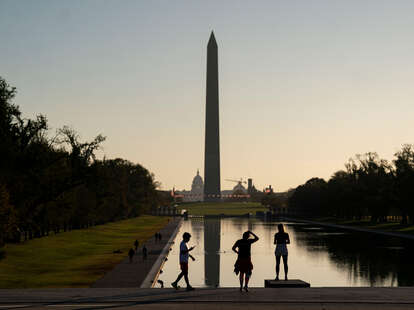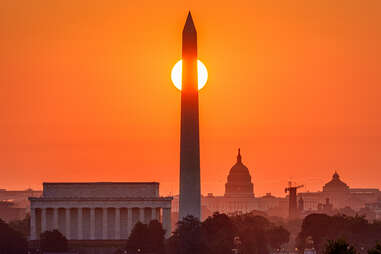12 Things You Probably Didn’t Know About the Washington Monument
The chief of communications for the National Mall and Memorial Parks gives Thrillist the insider intel.

If you’ve ever watched a movie about an alien invasion, specifically Earth vs. the Flying Saucers (1956), Mars Attacks! (1998) or any movie in the Marvel Universe that contains close encounters of the third kind, you’ve seen the Washington Monument. An iconic American historical landmark located in Washington DC’s National Mall, the monument is a stone obelisk stretching 555 feet into the sky. It was built to commemorate founding father George Washington and remains the world’s tallest predominately stone structure—and an essential tourist locale for US history fans.
Whether you’re a local or a first-time visitor to The District, there’s plenty of hidden or lesser-known trivia about this historically significant monument. Mike Litterst, chief of communications for the National Mall and Memorial Parks, helped us find the facts that only those in the know…know.
1. It was the tallest building in the world at the time of its completion
Although the Washington Monument is tall, it’s far from the tallest in the world. (That title is currently held by the 2,717-feet-tall Burj Khalifa in Dubai.) However, Litterst points out, modern tourists look up at it and think Wow, that’s pretty tall if we stretch our imaginations to when it was completed in 1888. This was the tallest structure in the world at that time. (The Eiffel tower would blow the monument out of the water for the tallest building shortly thereafter.)
2. It has a color shift about a third of the way up.
Visitors to the monument can see a slight shift in color about a third of the way up the obelisk. And, no, it’s not from the high water line of a recent flood. (Litterst said most of the staff at the monument has a favorite not-factually-based reason for the change in hue.) The truth is there was a pause in the construction of the monument from 1854 to 1877 due to funding challenges. (The cost of the original design, adjusted for modern inflation, would’ve been around $30,000,000 in 2024.) Thus, the Army Corps of Engineers who took over the project had to seek out stone from a different quarry and the coloration of the obelisk was changed.
3. The Army Corps of Engineers had to dramatically fix the monument’s thickness.
The aforementioned first third of the obelisk was constructed by the Washington National Monument Society. They took it upon themselves to make this monument happen, spurred on by their patriotic fanfare for George Washington, according to the National Park Service’s website. They got an original design from Robert Mills, an American cartographer and architect from South Carolina, and set to work.
When they hit a funding roadblock, the Army Corps of Engineers took over. This was also a very different level of building professionalism from the Army Corps of Engineers, said Litterst. There’s a big difference between engineers from the U.S. government and a “bunch of guys getting together.”
Thus, when it was eventually taken over by the engineers, a few errors had to be corrected. The walls were way too thick. At the base of the statue you’ll still find that the walls are around 15 feet thick. It was determined, according to Litterst, that if the entire monument was built with the walls that same thickness, it would collapse in on itself due to the sheer weight.
The thickness of the walls dramatically changes farther up the statue. The top section of the monument’s walls are just 18 inches thick. The foundation was also completely inadequate for the expected height of the structure and had to be fixed over the course of a few years. The angle also had to be corrected as the bottom third of the structure was sitting a few degrees off of perpendicular with the dirt below.

4. This is a far cry from the original design.
The original design the Washington National Monument Society sought to build is far different from the classic Egyptian-style obelisk we see standing today. The original design, according to Litterst, called for not only a colonnade-looking building encircling the bottom of a 600-foot column, but also a statue of Washington himself standing in a chariot and holding the reins of six horses. Inside the colonnade would be statues of 30 prominent Revolutionary War heroes as well as statues of the signers of the Declaration of Independence.
Architect Henry Robinson Searle from Rochester, New York had objections to the original design, according to a book entitled Washington Monument Monograph which was originally published by Gibson Bros. printers in 1847 and made public (and available via internet) by the Library of Congress.
“First, would the foundation sustain the weight of the required height, and especially with the increased localized pressure in a storm of wind; second, the mere obelisk appeared only as an enlarged plagiarism, in no way illustrating the memory of Washington personally, or those connected with him, or the history of this growing country; third, there is nothing whatever aesthetic about it, and nothing that would impress the visitor, whether native or foreign, with the grandeur of the work of Washington and his coadjutors in founding this nation.”
Boom, roasted.
5. Elevator rides of yore were much much slower.
The elevator to the top of the Washington Monument today takes about 70 seconds. It’s the same as going up to the top floor of a 50-story building. This is also the fifth elevator this structure has had installed since its construction. The original steam-powered elevator took a whopping 10 to 12 minutes to get to the top.
6. It’s capped with aluminum (which used to be a lot more impressive).
Litters revealed that the monument is capped with 100 ounces of pure aluminum. Today, that doesn’t seem so incredible given our grocery-store access to rolls of the element. If we once again put ourselves in the shoes of Americans at the time when the metal was put onto the monument, around 1884, aluminum ore had just begun being processed and was, ounce for ounce, just as valuable as silver. Imagine that the monument was capped in pure silver or gold and that’s a comparable example for its value at the time the monument was being built, Litterst points out.

7. It’s held together by gravity.
There is a piece of glory that this monument has held on to despite its loss of the world’s tallest building title. The structure has no internal scaffolding. It has no metal internal structure holding it up, in fact it’s only held together by gravity and force of friction between the stones. Therefore, the structure gets to keep the title of the tallest freestanding stone structure.
8. It’s undergone several restorations.
Since it’s a free-standing structure, the monument is incredibly difficult to maintain. Each time maintenance needs to be done on the marble all 555 feet of the thing needs to be covered by scaffolding. That said, it was restored once in the 1930s, as a part of a WPA (Work Progress Administration) project. Again in the 1960s around the National Park Service’s 50th anniversary. It was called mission 66. Between 1998 and 2001 it was scaffolded as a part of a program called Save America’s Treasures. And finally, most recently, between 2011 and 2014 it needed maintenance following the 2011 Virginia Earthquake. Each time the structure is scaffolded, according to Litterst, it takes 35 miles of piping which is then made into a temporary structure around the monument.
9. Somehow the pope is involved.
On the day it opened to the public, there were stones from all 50 states and about a dozen countries inside the structure. There was even a piece of marble from the Acropolis in Athens, according to Litterst. Even Pope Pius IX sent in a stone. Today you can see 194 different commemorative stones ranging from important historical figures to run-of-the-mill George Washington admirers.
10. It was, in part, constructed in 20-foot segments.
As we’ve covered, the monument doesn’t currently have any scaffolding supporting the stone structure. During its construction, it was a different story. After the bottom third, the U.S. Army Corps of Engineers began constructing the monument in 20-foot segments. During the construction of these stone segments there was internal scaffolding for builders to use. They would build 20 feet up, then move up the iron scaffolding, then build another 20 feet. A steam-powered elevator was used to lift up to six tones of stone up the moveable iron frame. The process of building up these stone segments was comparable to the modern experience of building legos (on an entirely different scale) according to Litterst.
11. The cornerstone ceremony was a star-studded event.
In 1848, when construction began on the monument, there was a ceremony. 20,000 people came to watch, including some household names. President James K. Polk was there. A handful of future presidents – specifically Buchanan, Lincoln, and Johnson – were in attendance. Eliza Hamilton, Alexander Hamilton’s window and distinct character in the modern musical with their shared last name. Really, a who’s who of the 1848 political scene.
12. The cap was placed purposefully.
During the final stretch of the monument’s construction, there was the precarious business of attaching the pyramid-shaped topper. About 470 feet in the air, builders began tapering in the structure, according to the National Parks Service website. On December 6, 1884, the 3,300-pound capstone was placed atop the structure. It was brought out one of the windows, hoisted to the scaffolding at the top of the monument, and set in place. Lt. Col. Thomas Lincoln Casey, who led the Army Corps of Engineers’s work on the structure, then placed that 8.9-inch aluminum tip on the very top of the capstone.